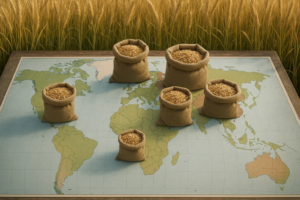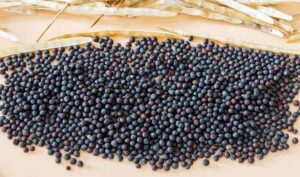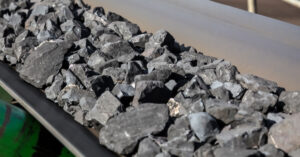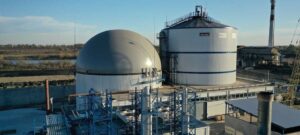
According to data from the Food and Agriculture Organization of the United Nations (FAO), in 2024 Ukraine ranked 9th in the world in wheat production, producing about 23.4 million tons of grain. This information is presented in a new study by Experts Club, based on FAOSTAT statistics and the video “Wheat Production by Country (1991–2024)”.
The top three wheat producers remain traditionally stable:
China — 136 million tons,
India — 113.9 million tons,
Russia — 81.6 million tons.
These three countries account for nearly half of global wheat production and play a crucial role in the world’s agricultural system.
They are followed by:
United States — 53.6 million tons,
France — 35.9 million tons,
Canada — 35.9 million tons,
Australia — 34.1 million tons,
Pakistan — 31.4 million tons,
Ukraine — 23.4 million tons,
Germany — 21.5 million tons.
The second ten producers are opened by Turkey (19 million tons) and Kazakhstan (18.6 million tons), with Italy (6.9 million tons) closing the list.
The Experts Club video analysis demonstrates significant structural changes in global wheat production over the past three decades. The video covers the period from 1991 to 2024. During this time, China and India have almost doubled their production thanks to increased yields and consistent government support for the agricultural sector.
Russia and Ukraine, after a sharp decline in the 1990s, made a remarkable recovery: in the early 1990s, Ukraine produced around 15 million tons, while by 2024 the volume had increased to 23–24 million tons — despite war-related risks and export restrictions.
Kazakhstan, traditionally focused on exports, has maintained its position, supplying grain to Central Asia and parts of China.
Despite military actions and damage to part of its infrastructure, Ukraine remains one of the world’s leading wheat exporters. The main factors behind this are high yields in southern and central regions, improved logistics through Danube ports, and export routes via Romania and Bulgaria.
According to FAO, in 2024 Ukraine exported about 17 million tons of wheat, keeping the country among the three largest global grain suppliers, along with Russia and the United States.
Experts from Experts Club note that growth in production across Asia and CIS countries compensates for declining yields in Europe and North America, which are affected by droughts and climate change. At the same time, Turkey, Iran, and Egypt are strengthening their roles as regional centers of processing and import.
Global markets expect wheat prices to stabilize within the range of 230–250 USD per ton, provided there are no new geopolitical shocks.
“Ukraine’s position in the TOP-10 global wheat producers is a testament to the resilience of its agricultural sector, even during wartime. With the expansion of domestic processing, Ukraine can reach 25–27 million tons of production in the coming years and strengthen its place among the world’s top five exporters.
At the same time, the grain market is becoming increasingly technology-driven: digitalization of agribusiness, precision farming, and climate-resilient wheat varieties will determine leadership in the next decade,” said Maksym Urakin, co-founder of the analytical center Experts Club.
Ukraine remains one of the few countries where the agricultural sector accounts for about 40% of foreign currency earnings. In 2024, wheat ranked second in export volume after corn, and revenues from grain sales exceeded 6 billion USD.
According to Experts Club forecasts, if the pace of infrastructure recovery continues and weather conditions remain favorable, Ukraine’s wheat production may reach 25 million tons in 2025, and exports could exceed 18 million tons.
The study was prepared by the analytical center Experts Club based on data from FAOSTAT, USDA, and IGC.
The video analysis “Wheat Production by Country 1991–2024” is available on the Experts Club Ukraine YouTube channel.
AGRICULTURE, EXPERTS CLUB, EXPORT, FAO, GLOBAL PRODUCTION, UKRAINE, WHEAT

Rapeseed processing in Ukraine in 2024/2025 MY amounted to 0.5 million tons, or 14% of rapeseed production, according to the Ukroliyaprom association.
“It was not possible to use rapeseed for processing, as in the previous marketing year (when a record amount of over 1.0 million tons was processed), due to its massive export (almost 90% of its production). 3.1 million tons of rapeseed were exported, or over 86% of its production. Only over 0.5 million tons, or 14% of rapeseed production, was processed,” the industry association said.
Ukroliyaprom added that rapeseed oil exports in the 2024/2025 season amounted to 210,400 tons, worth $194 million, of which 153,500 tons (worth $144.1 million) were shipped to EU countries.
The top 10 countries purchasing Ukrainian rapeseed oil included China (48.3 thousand tons), Poland (46.1 thousand tons), Belgium (26.5 thousand tons), Lithuania (23.1 thousand tons), the Netherlands (15.2 thousand tons), Spain (13 thousand tons), Italy (9 thousand tons), Bulgaria (8.2 thousand tons), Germany (4.3 thousand tons), and Latvia (3.6 thousand tons).
Exports of rapeseed meal in 2024/2025 MY amounted to 218.5 thousand tons worth $53.9 million at an average price of $246.7 per ton. At the same time, 86.9% of rapeseed meal was supplied to EU countries, 9.9% was purchased by Israel, and 3.2% by Turkey.
The main importers of rapeseed meal were Spain (95.7 thousand tons), Hungary (39.7 thousand tons), Lithuania (21.4 thousand tons), France (15 thousand tons), Italy (5.9 thousand tons), Poland (5.5 thousand tons), Israel (21.8 thousand tons), and Turkey (6.9 thousand tons).
The processing season for rapeseed harvested in 2025 began in July of this year. In July-August, only about 60 thousand tons of rapeseed were processed into oil, which allowed for the production and export of 25.0 thousand tons of rapeseed oil.
At the same time, in September 2025, under the conditions of export duties on rapeseed, its processing at domestic enterprises increased to a record monthly volume of 250 thousand tons. According to Ukroliyaprom’s estimates, production reached 120,000 tons, of which 108,800 tons were exported for $121.9 million. This represents a 2.8- and 3.3-fold increase over the same period last year. The cost of one ton of exported oil increased in the current marketing year compared to the previous one to $1,120.4 per ton, or by $171.4 per ton.
The main consumers of Ukrainian rapeseed oil in September 2025 were EU countries, which imported 92 thousand tons from Ukraine, or 84.5% of the total exports of this product from Ukraine.
Among EU countries, the largest importers were the Netherlands, which purchased 29,000 tons of rapeseed oil, accounting for 27% of total exports, Belgium – 15,500 tons (14.2%), Spain – 14, 4 thousand tons (13.2%), and Poland – 13.5 thousand tons (12.4%).
16.8 thousand tons (15.5%) were exported to other countries, in particular, 13.9 thousand tons (15.5%) were exported to Singapore.
Ukroliyaprom reminded that on September 4, 2025, amendments to the law “On Export Duty Rates on Seeds of Certain Oil Crops” came into force, approving export duty rates of 10% of the customs value of goods for soybeans (UKTZED code 1201) and rapeseed (UKTZED code 1205). The association expressed hope for further positive results in the processing of rapeseed and soybeans, provided that the conditions for their processing remain in place.

In January-September this year, Ukraine reduced manganese ore exports by 78.3% compared to the same period last year, to 9,739 thousand tons, but in August-September, it stepped up deliveries.
According to statistics released by the State Customs Service (SCS), while shipments in the first seven months of 2025 amounted to 2,977 thousand tons, exports more than doubled in August, when 5,037 thousand tons were shipped, and 1,725 thousand tons in September.
In monetary terms, exports for the first nine months of 2025 fell by 75.4% compared to the same period in 2024, to $1.615 million. The main exports were to Slovakia (98.27% of shipments in monetary terms) and Poland (1.73%).
There were no imports of manganese ore during this period.
As reported, in January 2024, Ukraine exported 44,903 thousand tons of manganese ore worth $6.563 million to the US, ending a two-year absence of supplies to foreign markets. In February-December 2024, there were no exports of manganese ore.
At the same time, for the whole of 2024, the country imported 84,293 thousand tons worth $18.302 million from Ghana (98.85%), Brazil (0.99%), and Belgium (0.11%). There were no imports in October-November.
Ukraine did not export manganese ore in 2022 and 2023, and in 2021 it exported 770 tons worth $89 thousand.
In addition, it was reported that the Pokrovsky Mining and Processing Plant (PGZK, formerly Ordzhonikidze Mining and Processing Plant) and the Marganetsky Mining and Processing Plant (MGZK, both in Dnipropetrovsk region), which are part of the Privat Group, stopped mining and processing raw manganese ore in late October-early November 2023, while NZF and ZZF stopped smelting ferroalloys. In the summer of 2024, ferroalloy plants resumed production at a minimum level.
PGZK and MGZK did not produce any products in 2024, while in 2023, PGZK produced 160.31 thousand tons of manganese concentrate, and MGZK was idle.
In Ukraine, manganese ore is mined and enriched by the Pokrovsky and Marganets mining and enrichment plants.
The consumers of manganese ore are ferroalloy enterprises.

Imports of goods from Ukraine in January-September 2025 amounted to $60.1 billion in monetary terms, which is 17.4% higher than in the same period of 2024, while exports decreased by 3.1% to $29.5 billion, according to the State Customs Service (SCS).
“At the same time, taxable imports amounted to $45.9 billion, which is 76% of the total volume of imported goods. The tax burden per 1 kg of taxable imports in January-September 2025 was $0.52/kg,” the agency’s Telegram channel reported on Wednesday.
Traditionally, China imported the most goods to Ukraine – $13.3 billion, followed by Poland – $5.7 billion, and Germany – $4.8 billion.
Ukrainian goods were exported mainly to Poland – $3.7 billion, Turkey – $2.1 billion, and Germany – $1.8 billion.
Of the total volume of goods imported into the country in January-September 2025, 69% of the categories were machinery, equipment, and transport – $23.8 billion (with customs clearance, UAH 148.3 billion, or 29% of customs payments, was paid to the budget), chemical industry products – $9.4 billion (72.9 billion hryvnia paid to the budget, or 14% of revenues), fuel and energy – $7.6 billion (146.6 billion hryvnia paid, accounting for 29% of customs payments).
According to the State Customs Service, the top three most exported Ukrainian goods were food products – $16.2 billion, metals and metal products – $3.4 billion, and machinery, equipment, and transport – $2.8 billion.
“In the first nine months of 2025, UAH 641.9 million was paid to the budget during customs clearance of exports of goods subject to export duties,” the service concluded.

In September 2025, YUM Liquid Gas LLC exported Ukrainian-produced liquefied biomethane (bio-LNG) to Germany by tanker trucks for the first time, according to industry analytical agency ExPro Daily Gas.
According to the agency’s estimates, the company exported almost 60 tons of liquefied biomethane in September-October. The buyer was Cyprus-based Preture Liquid Gas. According to YouControl, it is the founder of YUM Biogas Company. Therefore, both companies belong to the same group of companies.
YUM Liquid Gas LLC produces biomethane from biogas at its own Yuzhefo-Mykolaiv Biogas Plant (Vinnytsia region). Biogas is produced from sugar beet pulp and broiler chicken manure.
Thus, YUM Liquid Gas has become the second Ukrainian company to export bio-LNG and the fourth company to export biomethane from Ukraine.
As reported, Oril Leader, part of the MHP agricultural holding, also exports bio-LNG to Germany, having supplied almost 2,800 tons since May 2025.
On February 7, 2025, VITAGRO exported biomethane from Ukraine for the first time. On February 11, MHP joined it, and in June, Gals Agro made its first export of gaseous biomethane.
According to information from the Ukrainian Gas Transmission System Operator, as of mid-2025, there were four biomethane plants operating in Ukraine with a capacity of 41 million cubic meters of biomethane per year, three of which are already commercially supplying biomethane to the gas transmission system. By the end of 2025, biomethane producers plan to commission additional biomethane plants with a capacity of up to 70 million cubic meters of biomethane per year and bring the total capacity to 111 million cubic meters per year.